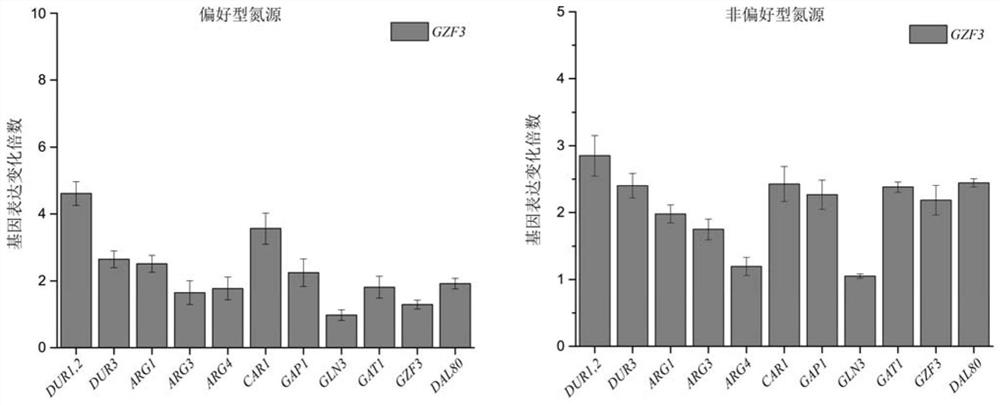A method to localize gzf3 to the cytoplasm to reduce urea accumulation in rice wine yeast
A technology of rice wine yeast and cytoplasm, applied in the field of genetic engineering, can solve problems such as affecting the safety of rice wine products
- Summary
- Abstract
- Description
- Claims
- Application Information
AI Technical Summary
Problems solved by technology
Method used
Image
Examples
Embodiment 1
[0029] Example 1 The construction of rice wine yeast suitable for rapamycin-mediated regulatory protein subcellular localization
[0030] (1) Split the diploid Saccharomyces cerevisiae strain XZ-11 used for rice wine production to obtain haploid strains
[0031] According to the paper "Wu D H, Li X M, Shen C, et al.Isolation of a haploid from anindustrial Chinese rice wine yeast for metabolic engineering manipulation[J].Journal of the Institute of Brewing,2013,119(4):288-293 The method and steps described in the method and steps to obtain the haploid XZ-11a strain without resistance gene.
[0032] (2) Construction of auxotrophic haploid rice wine yeast JNZ01
[0033] Using the genome of rice wine yeast XZ-11 strain as a template, the upstream and downstream 300 bp sequences of the URA3 gene were respectively amplified, and the above two amplified fragments were fused by fusion PCR to obtain the URA3 gene knockout frame. The URA3 knockout frame was transformed into the XZ-11a...
Embodiment 2
[0042] Example 2 Fusion PCR construction fusion expression GZF3, FKBP12 recombination cassette
[0043] (GGGGS) was first transformed by whole-plasmid PCR 3 After the linker was introduced into the BamH I site on the high-copy plasmid vector pRS426-TEF-URA3, pRS426-TEF-GS-URA3 was obtained. FKBP12 was obtained by gene synthesis, and cloned into the EcoR I and Xho I sites of the vector pRS426-TEF-GS-URA3 by enzyme digestion to obtain pRS426-TEF-GS-FKBP12-URA3. A 500bp sequence without a stop codon at the end of GZF3 was amplified from the genome and cloned into the Spe I and BamH I sites of the vector pRS426-TEF-GS-FKBP12-URA3 by restriction enzyme digestion to obtain pRS426-TEF-Gzf3D-GS -FKBP12-URA3. Then, the obtained plasmid was used as a template for PCR amplification, and the 50 bp sequence downstream of GZF3 was introduced into the upstream primer to obtain the fusion expression GZF3 and FKBP12 recombination frame.
Embodiment 3
[0044] Example 3 Integration and fusion expression of GZF3 and FKBP12 recombination cassettes on the genome of recombinant rice wine yeast JNZ01 through the CRISPR-Cas9 system
[0045] First, according to Yeastriction (http: / / yeastriction.tnw.tudelft.nl / #! / ), design the 20nt sequence (AAACAAGAAGGGAATAAAGG) required to edit the GZF3 site on the genome using the CRISPR-Cas9 system. Using the plasmid p426-SNR52p-gRNA.CAN1.Y-SUP4t (Addgene No. 43803) as a template, the 20nt sequence located at the CAN1 site on the original plasmid was replaced by the 20nt sequence by whole plasmid PCR to obtain p426-Gzf3sgRNA. The plasmid p414-TEF1p-Cas9-CYC1t (Addgene number 43802) was transformed into the recombinant rice wine yeast JNZ01, on the SC-trp1 plate (YNB 1.7g / L, ammonium sulfate 5g / L, glucose 20g / L, uracil 25mg / L , agar powder 20g / L) to screen positive transformants to obtain bacterial strain JNZ01-Cas9. The plasmid p426-Gzf3sgRNA and the fusion expression GZF3 and FKBP12 recombinati...
PUM
 Login to View More
Login to View More Abstract
Description
Claims
Application Information
 Login to View More
Login to View More - R&D
- Intellectual Property
- Life Sciences
- Materials
- Tech Scout
- Unparalleled Data Quality
- Higher Quality Content
- 60% Fewer Hallucinations
Browse by: Latest US Patents, China's latest patents, Technical Efficacy Thesaurus, Application Domain, Technology Topic, Popular Technical Reports.
© 2025 PatSnap. All rights reserved.Legal|Privacy policy|Modern Slavery Act Transparency Statement|Sitemap|About US| Contact US: help@patsnap.com



